Developing Individuals: CPD, HPW, PM, and Learning Cycles
VerifiedAdded on 2023/06/18
|17
|5597
|84
Report
AI Summary
This report examines the critical aspects of developing individuals within an organization, focusing on continuous professional development (CPD), high-performance working (HPW), and performance management (PM). It details the significance of CPD, methods for engaging in it, and the importance of recording and evaluating its impact. The report further explores frameworks for CPD, reflective learning, and the role of feedback in enhancing learning outcomes. It also discusses how to support both organizational and individual learning, the characteristics of a learning organization, and the differences between training and development. The learning cycle and potential barriers to learning are also addressed. The concept of high-performance working (HPW) is introduced, along with the characteristics of HPW organizations and the roles of external stakeholders and partnerships in HPWOs. Finally, the report delves into performance management (PM), organizational culture, the transformation process, and the developmental approach to PM, emphasizing the importance of aligning individual development with organizational goals. This document is available on Desklib, where students can find a wealth of academic resources.
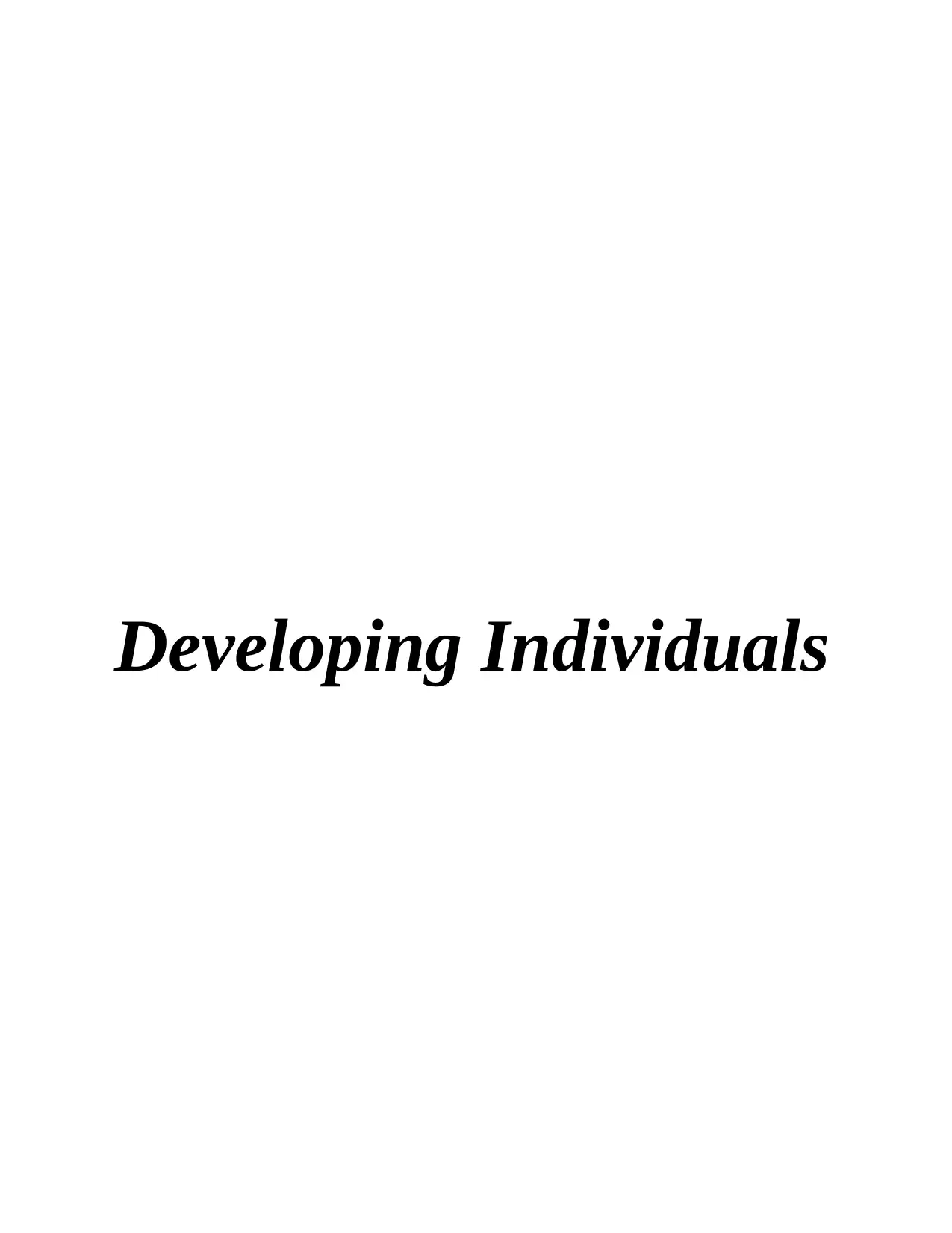
Developing Individuals
Paraphrase This Document
Need a fresh take? Get an instant paraphrase of this document with our AI Paraphraser
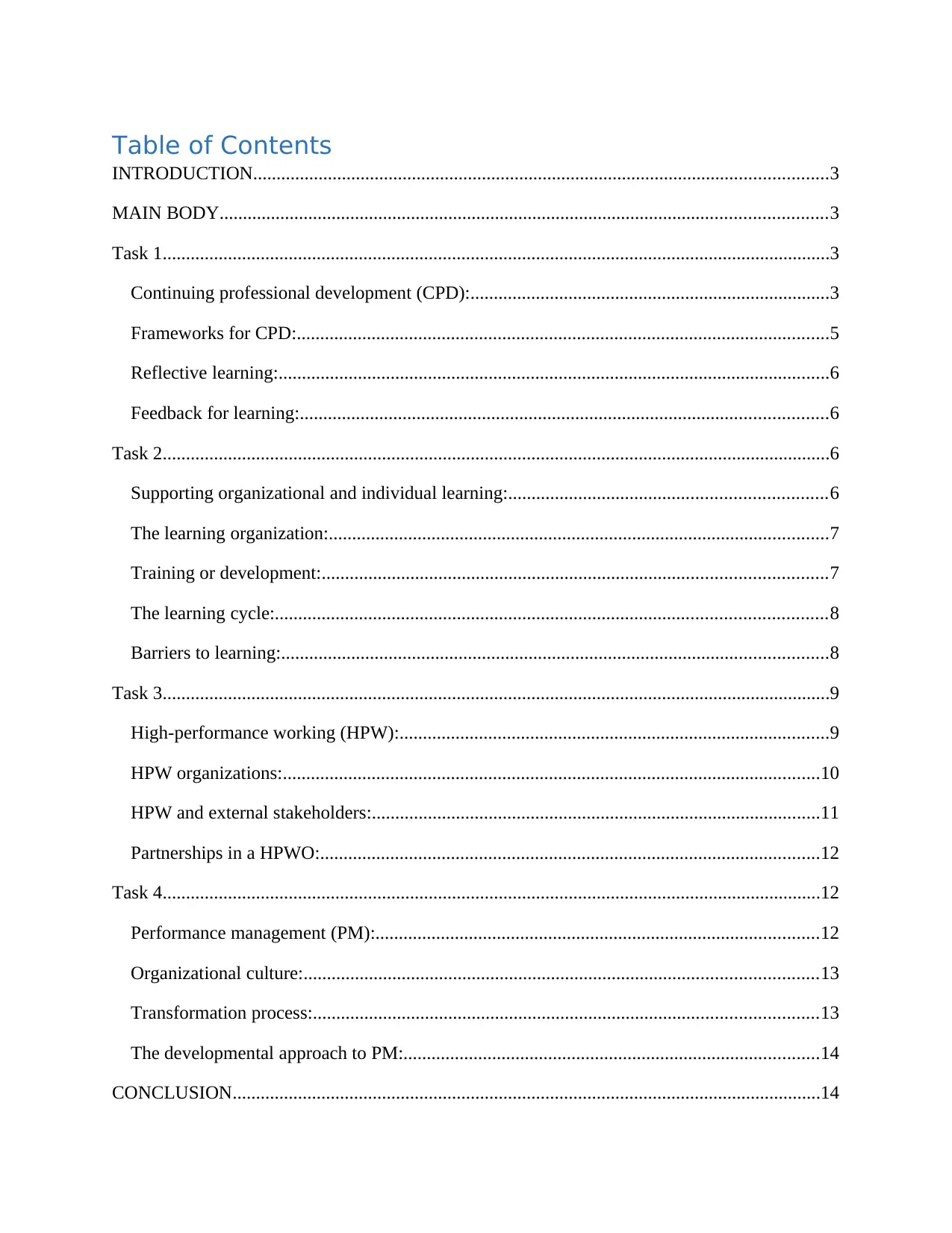
Table of Contents
INTRODUCTION...........................................................................................................................3
MAIN BODY..................................................................................................................................3
Task 1...............................................................................................................................................3
Continuing professional development (CPD):.............................................................................3
Frameworks for CPD:..................................................................................................................5
Reflective learning:......................................................................................................................6
Feedback for learning:.................................................................................................................6
Task 2...............................................................................................................................................6
Supporting organizational and individual learning:....................................................................6
The learning organization:...........................................................................................................7
Training or development:............................................................................................................7
The learning cycle:......................................................................................................................8
Barriers to learning:.....................................................................................................................8
Task 3...............................................................................................................................................9
High-performance working (HPW):............................................................................................9
HPW organizations:...................................................................................................................10
HPW and external stakeholders:................................................................................................11
Partnerships in a HPWO:...........................................................................................................12
Task 4.............................................................................................................................................12
Performance management (PM):...............................................................................................12
Organizational culture:..............................................................................................................13
Transformation process:............................................................................................................13
The developmental approach to PM:.........................................................................................14
CONCLUSION..............................................................................................................................14
INTRODUCTION...........................................................................................................................3
MAIN BODY..................................................................................................................................3
Task 1...............................................................................................................................................3
Continuing professional development (CPD):.............................................................................3
Frameworks for CPD:..................................................................................................................5
Reflective learning:......................................................................................................................6
Feedback for learning:.................................................................................................................6
Task 2...............................................................................................................................................6
Supporting organizational and individual learning:....................................................................6
The learning organization:...........................................................................................................7
Training or development:............................................................................................................7
The learning cycle:......................................................................................................................8
Barriers to learning:.....................................................................................................................8
Task 3...............................................................................................................................................9
High-performance working (HPW):............................................................................................9
HPW organizations:...................................................................................................................10
HPW and external stakeholders:................................................................................................11
Partnerships in a HPWO:...........................................................................................................12
Task 4.............................................................................................................................................12
Performance management (PM):...............................................................................................12
Organizational culture:..............................................................................................................13
Transformation process:............................................................................................................13
The developmental approach to PM:.........................................................................................14
CONCLUSION..............................................................................................................................14

REFERENCES..............................................................................................................................16
Books and Journal......................................................................................................................16
Books and Journal......................................................................................................................16
⊘ This is a preview!⊘
Do you want full access?
Subscribe today to unlock all pages.

Trusted by 1+ million students worldwide
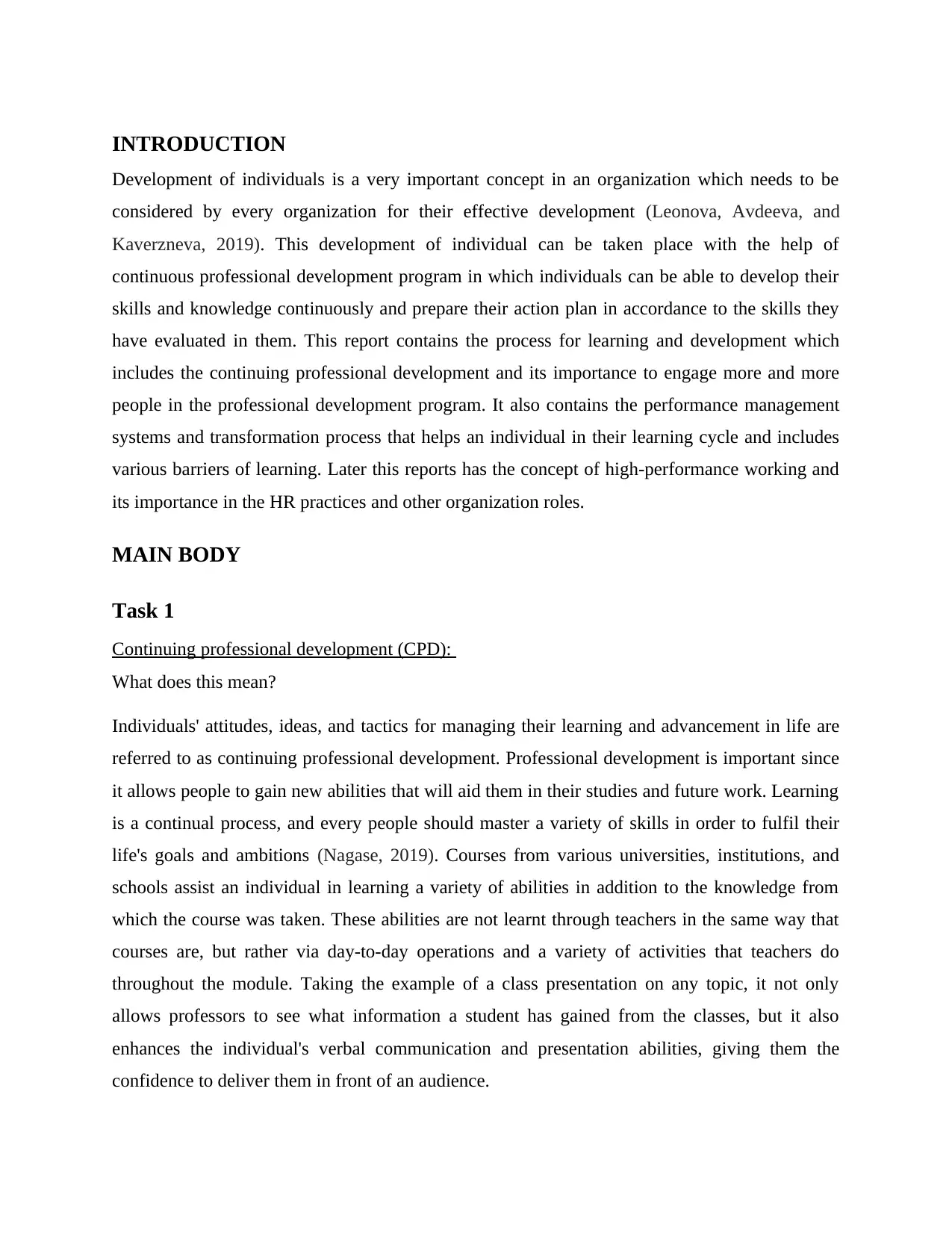
INTRODUCTION
Development of individuals is a very important concept in an organization which needs to be
considered by every organization for their effective development (Leonova, Avdeeva, and
Kaverzneva, 2019). This development of individual can be taken place with the help of
continuous professional development program in which individuals can be able to develop their
skills and knowledge continuously and prepare their action plan in accordance to the skills they
have evaluated in them. This report contains the process for learning and development which
includes the continuing professional development and its importance to engage more and more
people in the professional development program. It also contains the performance management
systems and transformation process that helps an individual in their learning cycle and includes
various barriers of learning. Later this reports has the concept of high-performance working and
its importance in the HR practices and other organization roles.
MAIN BODY
Task 1
Continuing professional development (CPD):
What does this mean?
Individuals' attitudes, ideas, and tactics for managing their learning and advancement in life are
referred to as continuing professional development. Professional development is important since
it allows people to gain new abilities that will aid them in their studies and future work. Learning
is a continual process, and every people should master a variety of skills in order to fulfil their
life's goals and ambitions (Nagase, 2019). Courses from various universities, institutions, and
schools assist an individual in learning a variety of abilities in addition to the knowledge from
which the course was taken. These abilities are not learnt through teachers in the same way that
courses are, but rather via day-to-day operations and a variety of activities that teachers do
throughout the module. Taking the example of a class presentation on any topic, it not only
allows professors to see what information a student has gained from the classes, but it also
enhances the individual's verbal communication and presentation abilities, giving them the
confidence to deliver them in front of an audience.
Development of individuals is a very important concept in an organization which needs to be
considered by every organization for their effective development (Leonova, Avdeeva, and
Kaverzneva, 2019). This development of individual can be taken place with the help of
continuous professional development program in which individuals can be able to develop their
skills and knowledge continuously and prepare their action plan in accordance to the skills they
have evaluated in them. This report contains the process for learning and development which
includes the continuing professional development and its importance to engage more and more
people in the professional development program. It also contains the performance management
systems and transformation process that helps an individual in their learning cycle and includes
various barriers of learning. Later this reports has the concept of high-performance working and
its importance in the HR practices and other organization roles.
MAIN BODY
Task 1
Continuing professional development (CPD):
What does this mean?
Individuals' attitudes, ideas, and tactics for managing their learning and advancement in life are
referred to as continuing professional development. Professional development is important since
it allows people to gain new abilities that will aid them in their studies and future work. Learning
is a continual process, and every people should master a variety of skills in order to fulfil their
life's goals and ambitions (Nagase, 2019). Courses from various universities, institutions, and
schools assist an individual in learning a variety of abilities in addition to the knowledge from
which the course was taken. These abilities are not learnt through teachers in the same way that
courses are, but rather via day-to-day operations and a variety of activities that teachers do
throughout the module. Taking the example of a class presentation on any topic, it not only
allows professors to see what information a student has gained from the classes, but it also
enhances the individual's verbal communication and presentation abilities, giving them the
confidence to deliver them in front of an audience.
Paraphrase This Document
Need a fresh take? Get an instant paraphrase of this document with our AI Paraphraser
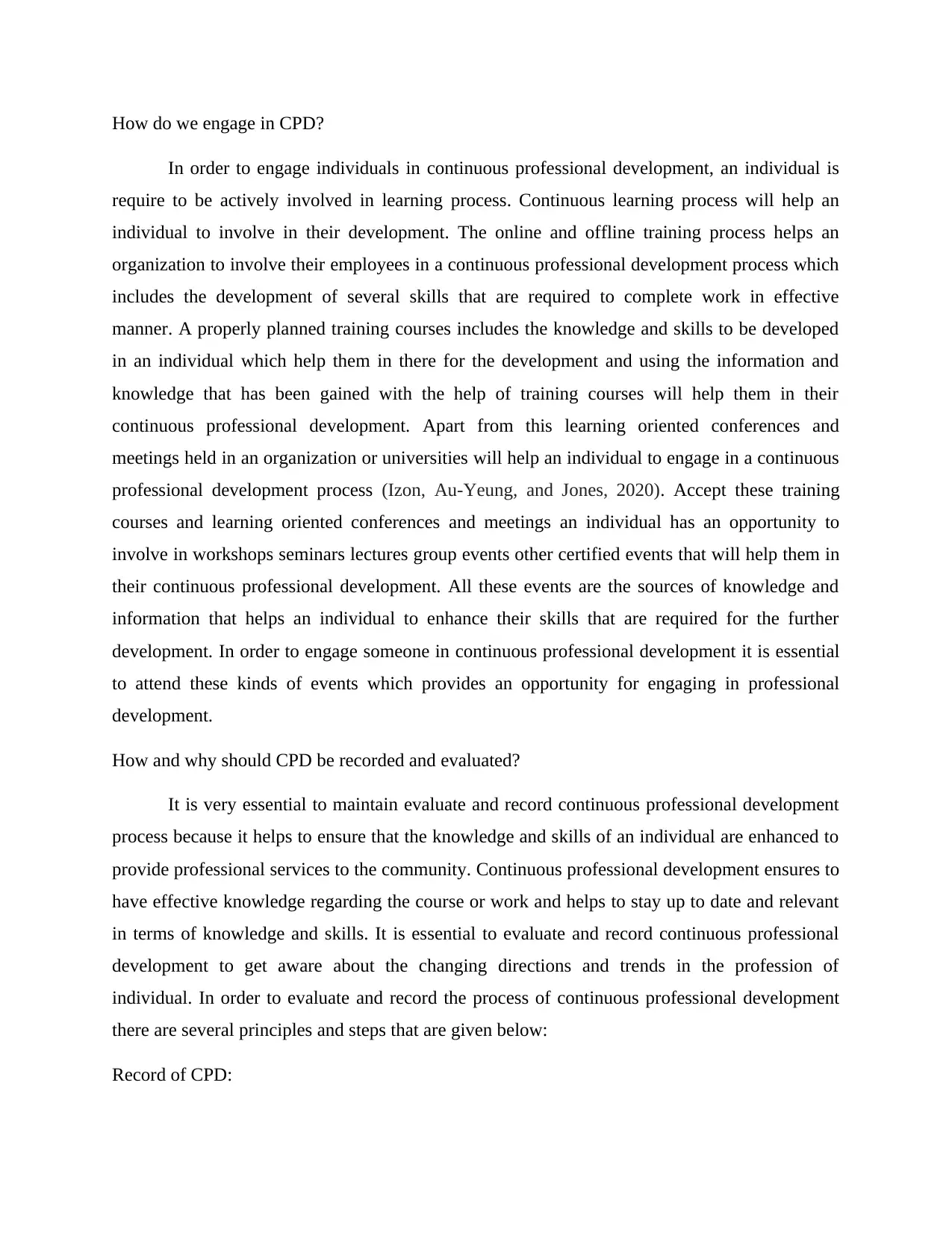
How do we engage in CPD?
In order to engage individuals in continuous professional development, an individual is
require to be actively involved in learning process. Continuous learning process will help an
individual to involve in their development. The online and offline training process helps an
organization to involve their employees in a continuous professional development process which
includes the development of several skills that are required to complete work in effective
manner. A properly planned training courses includes the knowledge and skills to be developed
in an individual which help them in there for the development and using the information and
knowledge that has been gained with the help of training courses will help them in their
continuous professional development. Apart from this learning oriented conferences and
meetings held in an organization or universities will help an individual to engage in a continuous
professional development process (Izon, Au-Yeung, and Jones, 2020). Accept these training
courses and learning oriented conferences and meetings an individual has an opportunity to
involve in workshops seminars lectures group events other certified events that will help them in
their continuous professional development. All these events are the sources of knowledge and
information that helps an individual to enhance their skills that are required for the further
development. In order to engage someone in continuous professional development it is essential
to attend these kinds of events which provides an opportunity for engaging in professional
development.
How and why should CPD be recorded and evaluated?
It is very essential to maintain evaluate and record continuous professional development
process because it helps to ensure that the knowledge and skills of an individual are enhanced to
provide professional services to the community. Continuous professional development ensures to
have effective knowledge regarding the course or work and helps to stay up to date and relevant
in terms of knowledge and skills. It is essential to evaluate and record continuous professional
development to get aware about the changing directions and trends in the profession of
individual. In order to evaluate and record the process of continuous professional development
there are several principles and steps that are given below:
Record of CPD:
In order to engage individuals in continuous professional development, an individual is
require to be actively involved in learning process. Continuous learning process will help an
individual to involve in their development. The online and offline training process helps an
organization to involve their employees in a continuous professional development process which
includes the development of several skills that are required to complete work in effective
manner. A properly planned training courses includes the knowledge and skills to be developed
in an individual which help them in there for the development and using the information and
knowledge that has been gained with the help of training courses will help them in their
continuous professional development. Apart from this learning oriented conferences and
meetings held in an organization or universities will help an individual to engage in a continuous
professional development process (Izon, Au-Yeung, and Jones, 2020). Accept these training
courses and learning oriented conferences and meetings an individual has an opportunity to
involve in workshops seminars lectures group events other certified events that will help them in
their continuous professional development. All these events are the sources of knowledge and
information that helps an individual to enhance their skills that are required for the further
development. In order to engage someone in continuous professional development it is essential
to attend these kinds of events which provides an opportunity for engaging in professional
development.
How and why should CPD be recorded and evaluated?
It is very essential to maintain evaluate and record continuous professional development
process because it helps to ensure that the knowledge and skills of an individual are enhanced to
provide professional services to the community. Continuous professional development ensures to
have effective knowledge regarding the course or work and helps to stay up to date and relevant
in terms of knowledge and skills. It is essential to evaluate and record continuous professional
development to get aware about the changing directions and trends in the profession of
individual. In order to evaluate and record the process of continuous professional development
there are several principles and steps that are given below:
Record of CPD:
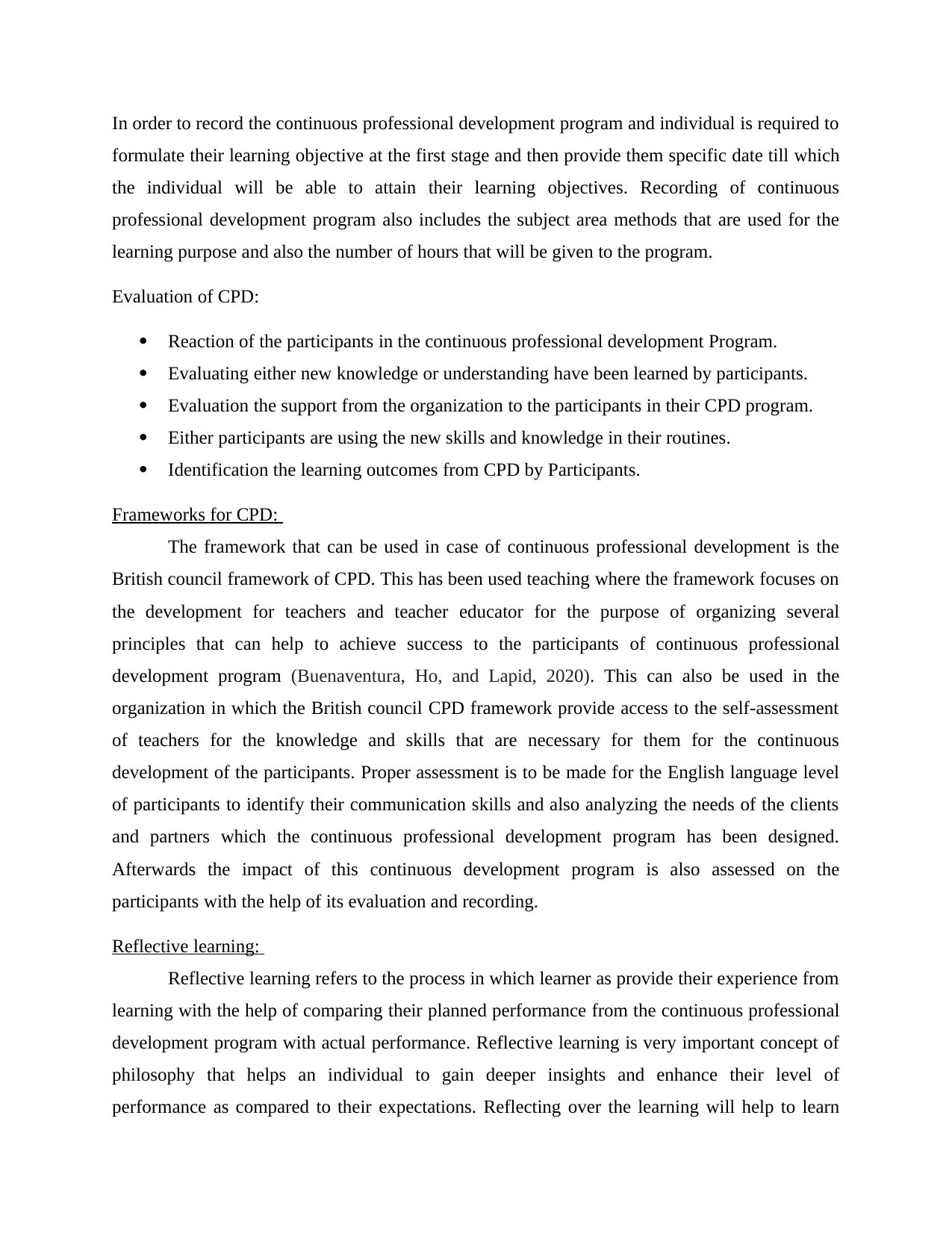
In order to record the continuous professional development program and individual is required to
formulate their learning objective at the first stage and then provide them specific date till which
the individual will be able to attain their learning objectives. Recording of continuous
professional development program also includes the subject area methods that are used for the
learning purpose and also the number of hours that will be given to the program.
Evaluation of CPD:
Reaction of the participants in the continuous professional development Program.
Evaluating either new knowledge or understanding have been learned by participants.
Evaluation the support from the organization to the participants in their CPD program.
Either participants are using the new skills and knowledge in their routines.
Identification the learning outcomes from CPD by Participants.
Frameworks for CPD:
The framework that can be used in case of continuous professional development is the
British council framework of CPD. This has been used teaching where the framework focuses on
the development for teachers and teacher educator for the purpose of organizing several
principles that can help to achieve success to the participants of continuous professional
development program (Buenaventura, Ho, and Lapid, 2020). This can also be used in the
organization in which the British council CPD framework provide access to the self-assessment
of teachers for the knowledge and skills that are necessary for them for the continuous
development of the participants. Proper assessment is to be made for the English language level
of participants to identify their communication skills and also analyzing the needs of the clients
and partners which the continuous professional development program has been designed.
Afterwards the impact of this continuous development program is also assessed on the
participants with the help of its evaluation and recording.
Reflective learning:
Reflective learning refers to the process in which learner as provide their experience from
learning with the help of comparing their planned performance from the continuous professional
development program with actual performance. Reflective learning is very important concept of
philosophy that helps an individual to gain deeper insights and enhance their level of
performance as compared to their expectations. Reflecting over the learning will help to learn
formulate their learning objective at the first stage and then provide them specific date till which
the individual will be able to attain their learning objectives. Recording of continuous
professional development program also includes the subject area methods that are used for the
learning purpose and also the number of hours that will be given to the program.
Evaluation of CPD:
Reaction of the participants in the continuous professional development Program.
Evaluating either new knowledge or understanding have been learned by participants.
Evaluation the support from the organization to the participants in their CPD program.
Either participants are using the new skills and knowledge in their routines.
Identification the learning outcomes from CPD by Participants.
Frameworks for CPD:
The framework that can be used in case of continuous professional development is the
British council framework of CPD. This has been used teaching where the framework focuses on
the development for teachers and teacher educator for the purpose of organizing several
principles that can help to achieve success to the participants of continuous professional
development program (Buenaventura, Ho, and Lapid, 2020). This can also be used in the
organization in which the British council CPD framework provide access to the self-assessment
of teachers for the knowledge and skills that are necessary for them for the continuous
development of the participants. Proper assessment is to be made for the English language level
of participants to identify their communication skills and also analyzing the needs of the clients
and partners which the continuous professional development program has been designed.
Afterwards the impact of this continuous development program is also assessed on the
participants with the help of its evaluation and recording.
Reflective learning:
Reflective learning refers to the process in which learner as provide their experience from
learning with the help of comparing their planned performance from the continuous professional
development program with actual performance. Reflective learning is very important concept of
philosophy that helps an individual to gain deeper insights and enhance their level of
performance as compared to their expectations. Reflecting over the learning will help to learn
⊘ This is a preview!⊘
Do you want full access?
Subscribe today to unlock all pages.

Trusted by 1+ million students worldwide
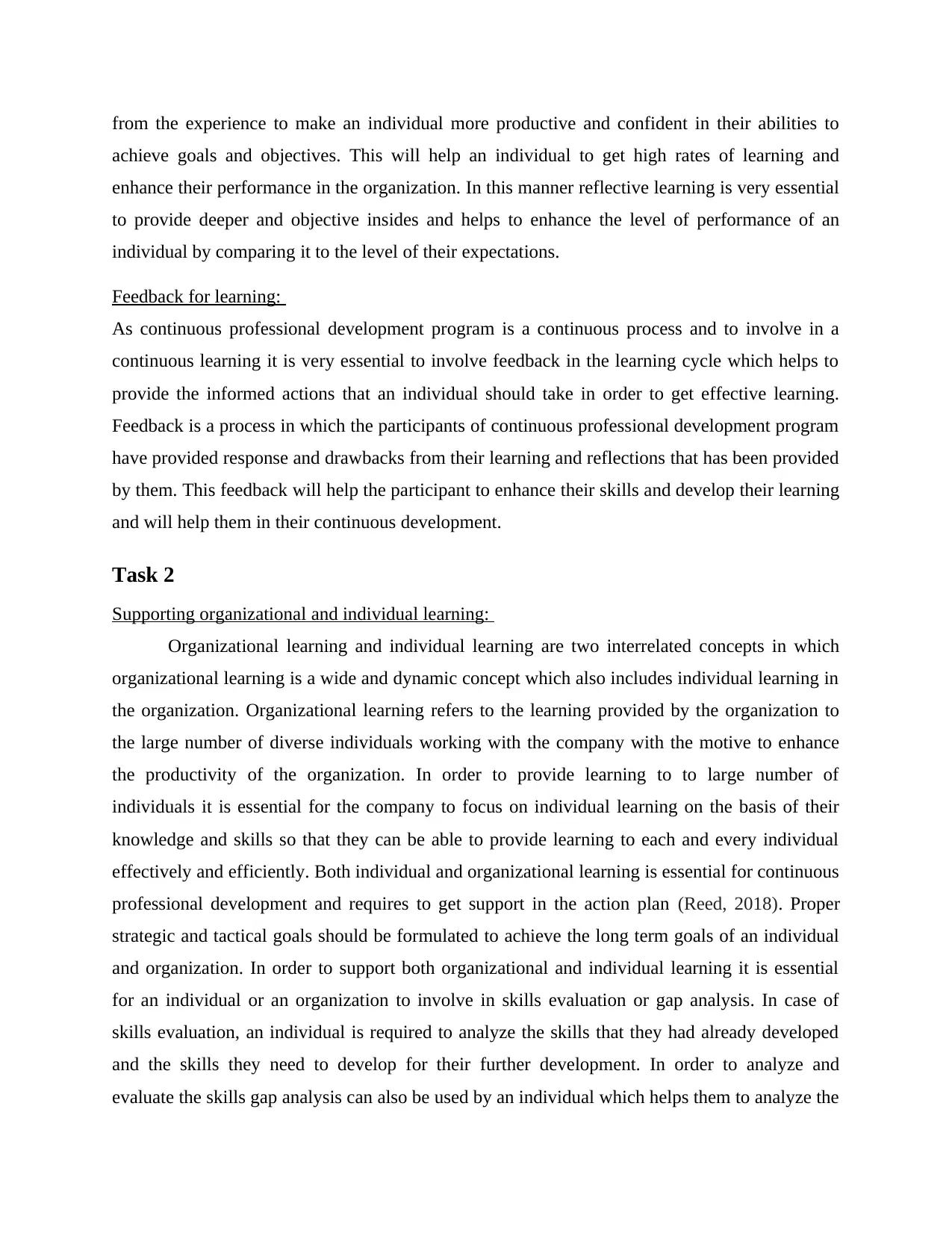
from the experience to make an individual more productive and confident in their abilities to
achieve goals and objectives. This will help an individual to get high rates of learning and
enhance their performance in the organization. In this manner reflective learning is very essential
to provide deeper and objective insides and helps to enhance the level of performance of an
individual by comparing it to the level of their expectations.
Feedback for learning:
As continuous professional development program is a continuous process and to involve in a
continuous learning it is very essential to involve feedback in the learning cycle which helps to
provide the informed actions that an individual should take in order to get effective learning.
Feedback is a process in which the participants of continuous professional development program
have provided response and drawbacks from their learning and reflections that has been provided
by them. This feedback will help the participant to enhance their skills and develop their learning
and will help them in their continuous development.
Task 2
Supporting organizational and individual learning:
Organizational learning and individual learning are two interrelated concepts in which
organizational learning is a wide and dynamic concept which also includes individual learning in
the organization. Organizational learning refers to the learning provided by the organization to
the large number of diverse individuals working with the company with the motive to enhance
the productivity of the organization. In order to provide learning to to large number of
individuals it is essential for the company to focus on individual learning on the basis of their
knowledge and skills so that they can be able to provide learning to each and every individual
effectively and efficiently. Both individual and organizational learning is essential for continuous
professional development and requires to get support in the action plan (Reed, 2018). Proper
strategic and tactical goals should be formulated to achieve the long term goals of an individual
and organization. In order to support both organizational and individual learning it is essential
for an individual or an organization to involve in skills evaluation or gap analysis. In case of
skills evaluation, an individual is required to analyze the skills that they had already developed
and the skills they need to develop for their further development. In order to analyze and
evaluate the skills gap analysis can also be used by an individual which helps them to analyze the
achieve goals and objectives. This will help an individual to get high rates of learning and
enhance their performance in the organization. In this manner reflective learning is very essential
to provide deeper and objective insides and helps to enhance the level of performance of an
individual by comparing it to the level of their expectations.
Feedback for learning:
As continuous professional development program is a continuous process and to involve in a
continuous learning it is very essential to involve feedback in the learning cycle which helps to
provide the informed actions that an individual should take in order to get effective learning.
Feedback is a process in which the participants of continuous professional development program
have provided response and drawbacks from their learning and reflections that has been provided
by them. This feedback will help the participant to enhance their skills and develop their learning
and will help them in their continuous development.
Task 2
Supporting organizational and individual learning:
Organizational learning and individual learning are two interrelated concepts in which
organizational learning is a wide and dynamic concept which also includes individual learning in
the organization. Organizational learning refers to the learning provided by the organization to
the large number of diverse individuals working with the company with the motive to enhance
the productivity of the organization. In order to provide learning to to large number of
individuals it is essential for the company to focus on individual learning on the basis of their
knowledge and skills so that they can be able to provide learning to each and every individual
effectively and efficiently. Both individual and organizational learning is essential for continuous
professional development and requires to get support in the action plan (Reed, 2018). Proper
strategic and tactical goals should be formulated to achieve the long term goals of an individual
and organization. In order to support both organizational and individual learning it is essential
for an individual or an organization to involve in skills evaluation or gap analysis. In case of
skills evaluation, an individual is required to analyze the skills that they had already developed
and the skills they need to develop for their further development. In order to analyze and
evaluate the skills gap analysis can also be used by an individual which helps them to analyze the
Paraphrase This Document
Need a fresh take? Get an instant paraphrase of this document with our AI Paraphraser
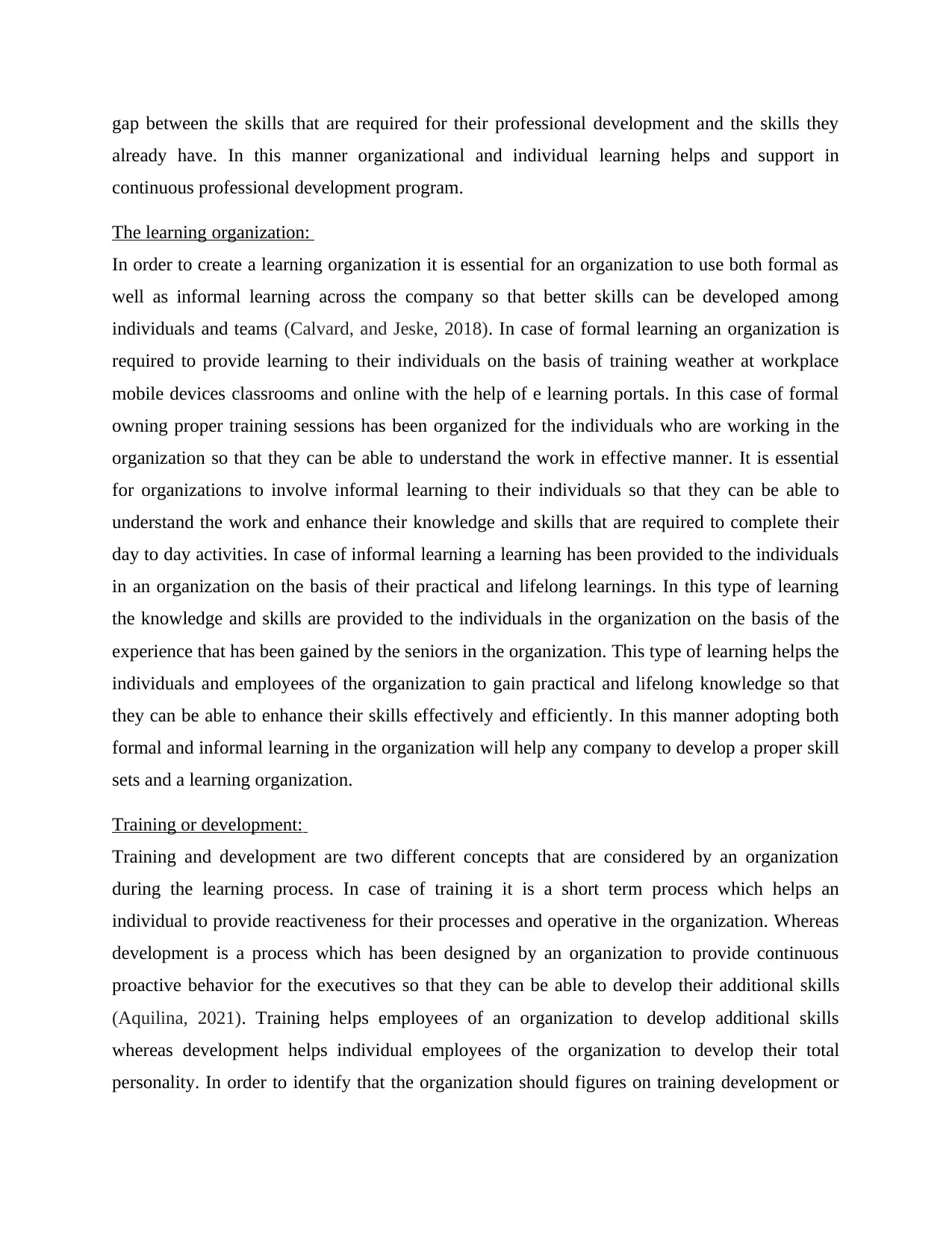
gap between the skills that are required for their professional development and the skills they
already have. In this manner organizational and individual learning helps and support in
continuous professional development program.
The learning organization:
In order to create a learning organization it is essential for an organization to use both formal as
well as informal learning across the company so that better skills can be developed among
individuals and teams (Calvard, and Jeske, 2018). In case of formal learning an organization is
required to provide learning to their individuals on the basis of training weather at workplace
mobile devices classrooms and online with the help of e learning portals. In this case of formal
owning proper training sessions has been organized for the individuals who are working in the
organization so that they can be able to understand the work in effective manner. It is essential
for organizations to involve informal learning to their individuals so that they can be able to
understand the work and enhance their knowledge and skills that are required to complete their
day to day activities. In case of informal learning a learning has been provided to the individuals
in an organization on the basis of their practical and lifelong learnings. In this type of learning
the knowledge and skills are provided to the individuals in the organization on the basis of the
experience that has been gained by the seniors in the organization. This type of learning helps the
individuals and employees of the organization to gain practical and lifelong knowledge so that
they can be able to enhance their skills effectively and efficiently. In this manner adopting both
formal and informal learning in the organization will help any company to develop a proper skill
sets and a learning organization.
Training or development:
Training and development are two different concepts that are considered by an organization
during the learning process. In case of training it is a short term process which helps an
individual to provide reactiveness for their processes and operative in the organization. Whereas
development is a process which has been designed by an organization to provide continuous
proactive behavior for the executives so that they can be able to develop their additional skills
(Aquilina, 2021). Training helps employees of an organization to develop additional skills
whereas development helps individual employees of the organization to develop their total
personality. In order to identify that the organization should figures on training development or
already have. In this manner organizational and individual learning helps and support in
continuous professional development program.
The learning organization:
In order to create a learning organization it is essential for an organization to use both formal as
well as informal learning across the company so that better skills can be developed among
individuals and teams (Calvard, and Jeske, 2018). In case of formal learning an organization is
required to provide learning to their individuals on the basis of training weather at workplace
mobile devices classrooms and online with the help of e learning portals. In this case of formal
owning proper training sessions has been organized for the individuals who are working in the
organization so that they can be able to understand the work in effective manner. It is essential
for organizations to involve informal learning to their individuals so that they can be able to
understand the work and enhance their knowledge and skills that are required to complete their
day to day activities. In case of informal learning a learning has been provided to the individuals
in an organization on the basis of their practical and lifelong learnings. In this type of learning
the knowledge and skills are provided to the individuals in the organization on the basis of the
experience that has been gained by the seniors in the organization. This type of learning helps the
individuals and employees of the organization to gain practical and lifelong knowledge so that
they can be able to enhance their skills effectively and efficiently. In this manner adopting both
formal and informal learning in the organization will help any company to develop a proper skill
sets and a learning organization.
Training or development:
Training and development are two different concepts that are considered by an organization
during the learning process. In case of training it is a short term process which helps an
individual to provide reactiveness for their processes and operative in the organization. Whereas
development is a process which has been designed by an organization to provide continuous
proactive behavior for the executives so that they can be able to develop their additional skills
(Aquilina, 2021). Training helps employees of an organization to develop additional skills
whereas development helps individual employees of the organization to develop their total
personality. In order to identify that the organization should figures on training development or
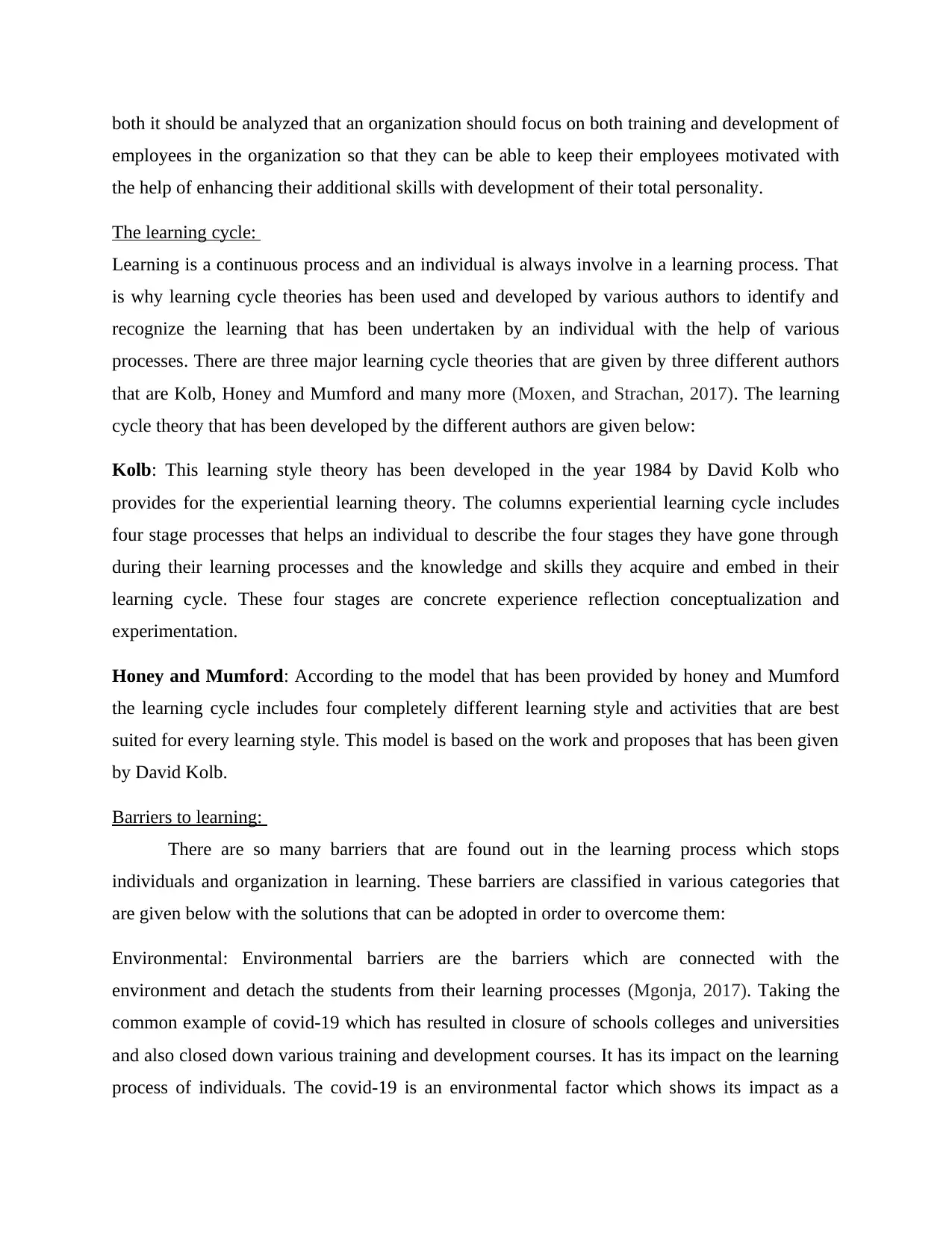
both it should be analyzed that an organization should focus on both training and development of
employees in the organization so that they can be able to keep their employees motivated with
the help of enhancing their additional skills with development of their total personality.
The learning cycle:
Learning is a continuous process and an individual is always involve in a learning process. That
is why learning cycle theories has been used and developed by various authors to identify and
recognize the learning that has been undertaken by an individual with the help of various
processes. There are three major learning cycle theories that are given by three different authors
that are Kolb, Honey and Mumford and many more (Moxen, and Strachan, 2017). The learning
cycle theory that has been developed by the different authors are given below:
Kolb: This learning style theory has been developed in the year 1984 by David Kolb who
provides for the experiential learning theory. The columns experiential learning cycle includes
four stage processes that helps an individual to describe the four stages they have gone through
during their learning processes and the knowledge and skills they acquire and embed in their
learning cycle. These four stages are concrete experience reflection conceptualization and
experimentation.
Honey and Mumford: According to the model that has been provided by honey and Mumford
the learning cycle includes four completely different learning style and activities that are best
suited for every learning style. This model is based on the work and proposes that has been given
by David Kolb.
Barriers to learning:
There are so many barriers that are found out in the learning process which stops
individuals and organization in learning. These barriers are classified in various categories that
are given below with the solutions that can be adopted in order to overcome them:
Environmental: Environmental barriers are the barriers which are connected with the
environment and detach the students from their learning processes (Mgonja, 2017). Taking the
common example of covid-19 which has resulted in closure of schools colleges and universities
and also closed down various training and development courses. It has its impact on the learning
process of individuals. The covid-19 is an environmental factor which shows its impact as a
employees in the organization so that they can be able to keep their employees motivated with
the help of enhancing their additional skills with development of their total personality.
The learning cycle:
Learning is a continuous process and an individual is always involve in a learning process. That
is why learning cycle theories has been used and developed by various authors to identify and
recognize the learning that has been undertaken by an individual with the help of various
processes. There are three major learning cycle theories that are given by three different authors
that are Kolb, Honey and Mumford and many more (Moxen, and Strachan, 2017). The learning
cycle theory that has been developed by the different authors are given below:
Kolb: This learning style theory has been developed in the year 1984 by David Kolb who
provides for the experiential learning theory. The columns experiential learning cycle includes
four stage processes that helps an individual to describe the four stages they have gone through
during their learning processes and the knowledge and skills they acquire and embed in their
learning cycle. These four stages are concrete experience reflection conceptualization and
experimentation.
Honey and Mumford: According to the model that has been provided by honey and Mumford
the learning cycle includes four completely different learning style and activities that are best
suited for every learning style. This model is based on the work and proposes that has been given
by David Kolb.
Barriers to learning:
There are so many barriers that are found out in the learning process which stops
individuals and organization in learning. These barriers are classified in various categories that
are given below with the solutions that can be adopted in order to overcome them:
Environmental: Environmental barriers are the barriers which are connected with the
environment and detach the students from their learning processes (Mgonja, 2017). Taking the
common example of covid-19 which has resulted in closure of schools colleges and universities
and also closed down various training and development courses. It has its impact on the learning
process of individuals. The covid-19 is an environmental factor which shows its impact as a
⊘ This is a preview!⊘
Do you want full access?
Subscribe today to unlock all pages.

Trusted by 1+ million students worldwide
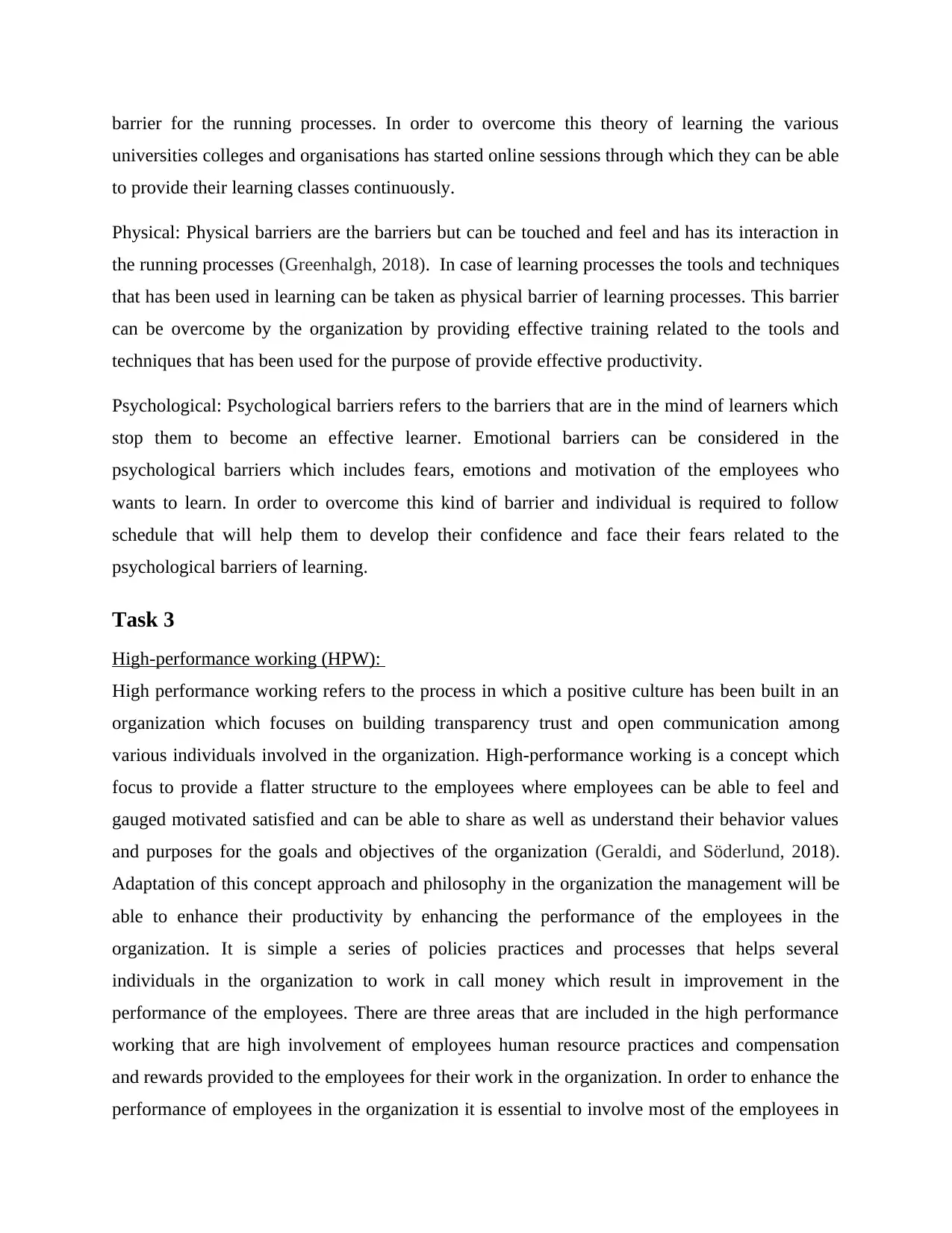
barrier for the running processes. In order to overcome this theory of learning the various
universities colleges and organisations has started online sessions through which they can be able
to provide their learning classes continuously.
Physical: Physical barriers are the barriers but can be touched and feel and has its interaction in
the running processes (Greenhalgh, 2018). In case of learning processes the tools and techniques
that has been used in learning can be taken as physical barrier of learning processes. This barrier
can be overcome by the organization by providing effective training related to the tools and
techniques that has been used for the purpose of provide effective productivity.
Psychological: Psychological barriers refers to the barriers that are in the mind of learners which
stop them to become an effective learner. Emotional barriers can be considered in the
psychological barriers which includes fears, emotions and motivation of the employees who
wants to learn. In order to overcome this kind of barrier and individual is required to follow
schedule that will help them to develop their confidence and face their fears related to the
psychological barriers of learning.
Task 3
High-performance working (HPW):
High performance working refers to the process in which a positive culture has been built in an
organization which focuses on building transparency trust and open communication among
various individuals involved in the organization. High-performance working is a concept which
focus to provide a flatter structure to the employees where employees can be able to feel and
gauged motivated satisfied and can be able to share as well as understand their behavior values
and purposes for the goals and objectives of the organization (Geraldi, and Söderlund, 2018).
Adaptation of this concept approach and philosophy in the organization the management will be
able to enhance their productivity by enhancing the performance of the employees in the
organization. It is simple a series of policies practices and processes that helps several
individuals in the organization to work in call money which result in improvement in the
performance of the employees. There are three areas that are included in the high performance
working that are high involvement of employees human resource practices and compensation
and rewards provided to the employees for their work in the organization. In order to enhance the
performance of employees in the organization it is essential to involve most of the employees in
universities colleges and organisations has started online sessions through which they can be able
to provide their learning classes continuously.
Physical: Physical barriers are the barriers but can be touched and feel and has its interaction in
the running processes (Greenhalgh, 2018). In case of learning processes the tools and techniques
that has been used in learning can be taken as physical barrier of learning processes. This barrier
can be overcome by the organization by providing effective training related to the tools and
techniques that has been used for the purpose of provide effective productivity.
Psychological: Psychological barriers refers to the barriers that are in the mind of learners which
stop them to become an effective learner. Emotional barriers can be considered in the
psychological barriers which includes fears, emotions and motivation of the employees who
wants to learn. In order to overcome this kind of barrier and individual is required to follow
schedule that will help them to develop their confidence and face their fears related to the
psychological barriers of learning.
Task 3
High-performance working (HPW):
High performance working refers to the process in which a positive culture has been built in an
organization which focuses on building transparency trust and open communication among
various individuals involved in the organization. High-performance working is a concept which
focus to provide a flatter structure to the employees where employees can be able to feel and
gauged motivated satisfied and can be able to share as well as understand their behavior values
and purposes for the goals and objectives of the organization (Geraldi, and Söderlund, 2018).
Adaptation of this concept approach and philosophy in the organization the management will be
able to enhance their productivity by enhancing the performance of the employees in the
organization. It is simple a series of policies practices and processes that helps several
individuals in the organization to work in call money which result in improvement in the
performance of the employees. There are three areas that are included in the high performance
working that are high involvement of employees human resource practices and compensation
and rewards provided to the employees for their work in the organization. In order to enhance the
performance of employees in the organization it is essential to involve most of the employees in
Paraphrase This Document
Need a fresh take? Get an instant paraphrase of this document with our AI Paraphraser
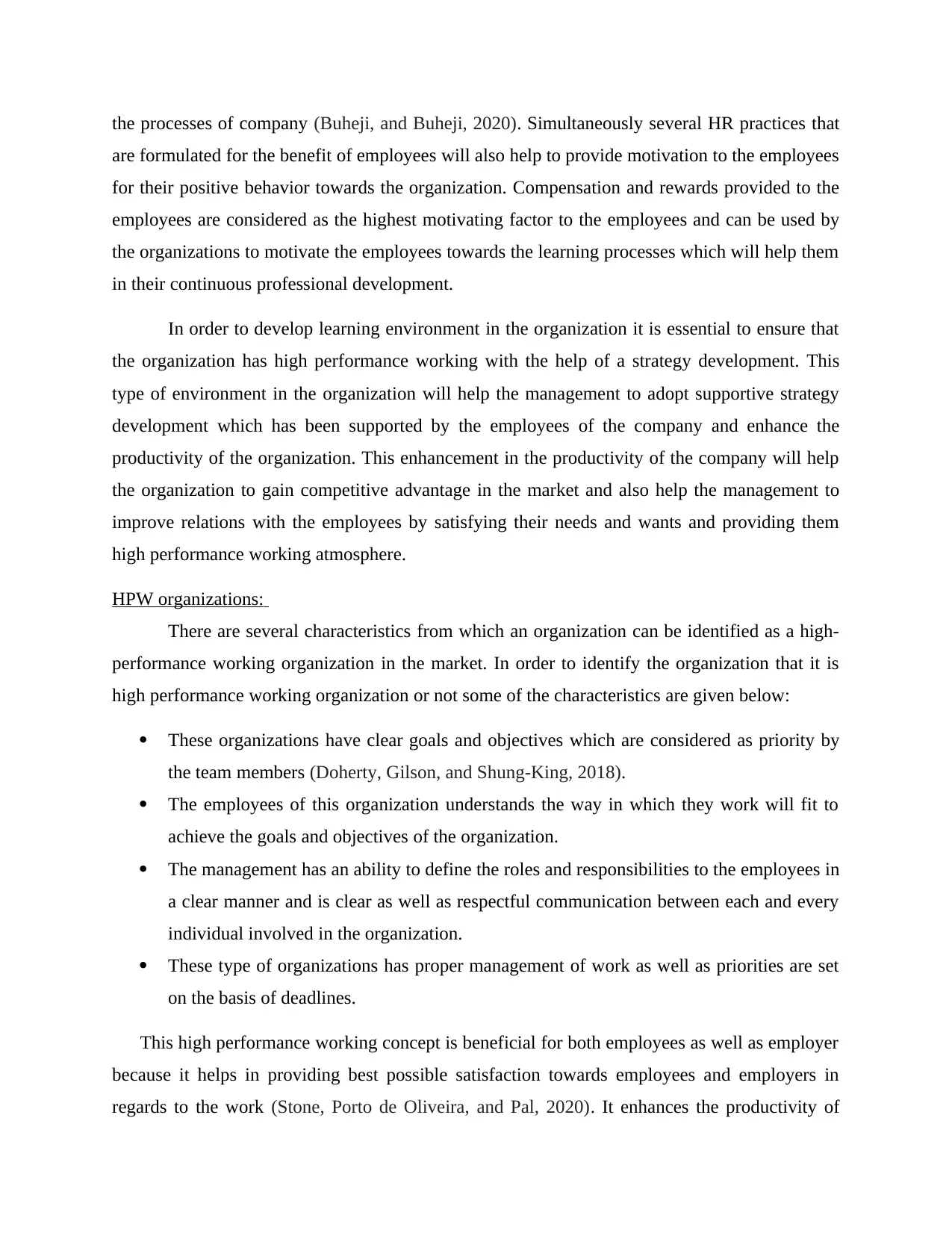
the processes of company (Buheji, and Buheji, 2020). Simultaneously several HR practices that
are formulated for the benefit of employees will also help to provide motivation to the employees
for their positive behavior towards the organization. Compensation and rewards provided to the
employees are considered as the highest motivating factor to the employees and can be used by
the organizations to motivate the employees towards the learning processes which will help them
in their continuous professional development.
In order to develop learning environment in the organization it is essential to ensure that
the organization has high performance working with the help of a strategy development. This
type of environment in the organization will help the management to adopt supportive strategy
development which has been supported by the employees of the company and enhance the
productivity of the organization. This enhancement in the productivity of the company will help
the organization to gain competitive advantage in the market and also help the management to
improve relations with the employees by satisfying their needs and wants and providing them
high performance working atmosphere.
HPW organizations:
There are several characteristics from which an organization can be identified as a high-
performance working organization in the market. In order to identify the organization that it is
high performance working organization or not some of the characteristics are given below:
These organizations have clear goals and objectives which are considered as priority by
the team members (Doherty, Gilson, and Shung-King, 2018).
The employees of this organization understands the way in which they work will fit to
achieve the goals and objectives of the organization.
The management has an ability to define the roles and responsibilities to the employees in
a clear manner and is clear as well as respectful communication between each and every
individual involved in the organization.
These type of organizations has proper management of work as well as priorities are set
on the basis of deadlines.
This high performance working concept is beneficial for both employees as well as employer
because it helps in providing best possible satisfaction towards employees and employers in
regards to the work (Stone, Porto de Oliveira, and Pal, 2020). It enhances the productivity of
are formulated for the benefit of employees will also help to provide motivation to the employees
for their positive behavior towards the organization. Compensation and rewards provided to the
employees are considered as the highest motivating factor to the employees and can be used by
the organizations to motivate the employees towards the learning processes which will help them
in their continuous professional development.
In order to develop learning environment in the organization it is essential to ensure that
the organization has high performance working with the help of a strategy development. This
type of environment in the organization will help the management to adopt supportive strategy
development which has been supported by the employees of the company and enhance the
productivity of the organization. This enhancement in the productivity of the company will help
the organization to gain competitive advantage in the market and also help the management to
improve relations with the employees by satisfying their needs and wants and providing them
high performance working atmosphere.
HPW organizations:
There are several characteristics from which an organization can be identified as a high-
performance working organization in the market. In order to identify the organization that it is
high performance working organization or not some of the characteristics are given below:
These organizations have clear goals and objectives which are considered as priority by
the team members (Doherty, Gilson, and Shung-King, 2018).
The employees of this organization understands the way in which they work will fit to
achieve the goals and objectives of the organization.
The management has an ability to define the roles and responsibilities to the employees in
a clear manner and is clear as well as respectful communication between each and every
individual involved in the organization.
These type of organizations has proper management of work as well as priorities are set
on the basis of deadlines.
This high performance working concept is beneficial for both employees as well as employer
because it helps in providing best possible satisfaction towards employees and employers in
regards to the work (Stone, Porto de Oliveira, and Pal, 2020). It enhances the productivity of
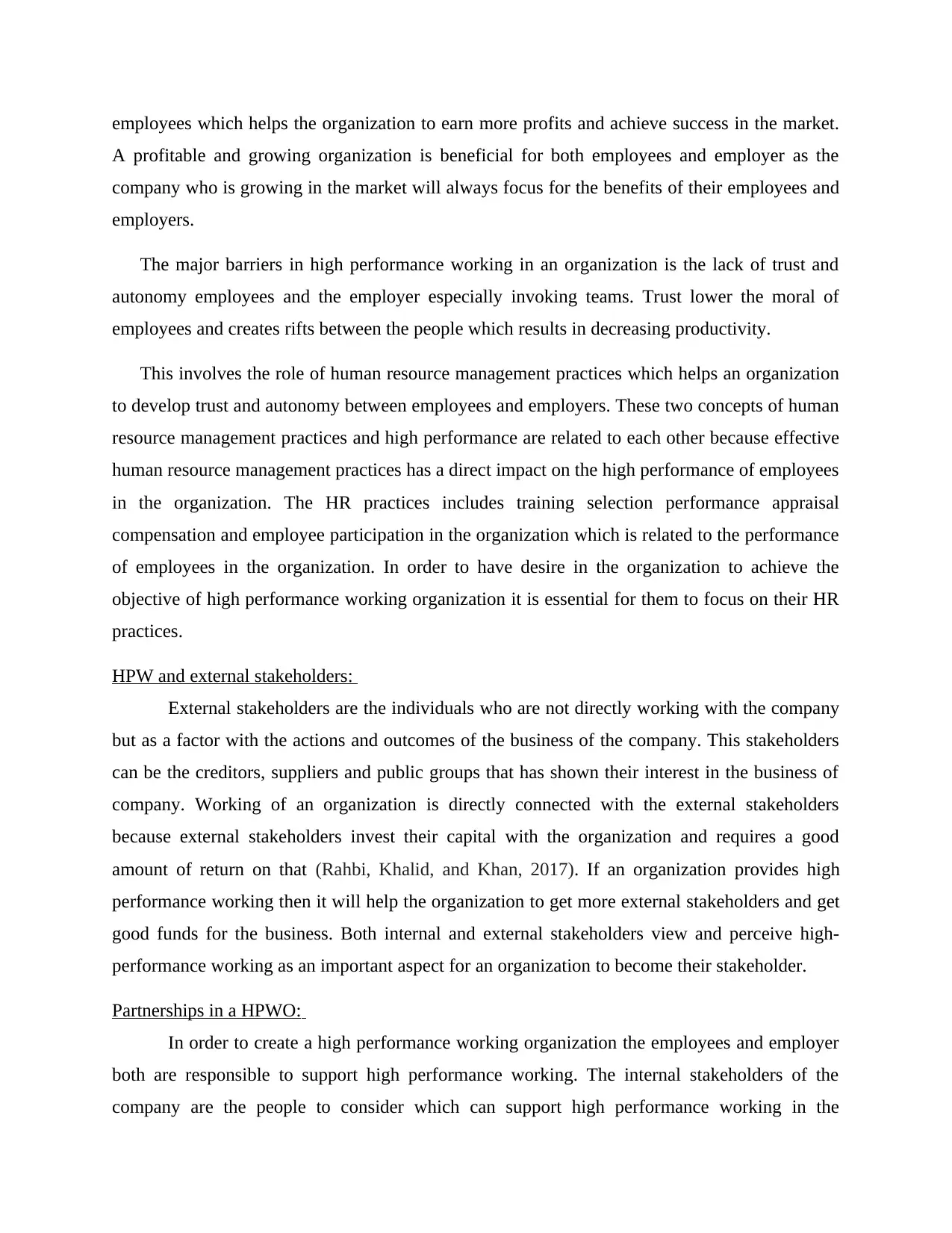
employees which helps the organization to earn more profits and achieve success in the market.
A profitable and growing organization is beneficial for both employees and employer as the
company who is growing in the market will always focus for the benefits of their employees and
employers.
The major barriers in high performance working in an organization is the lack of trust and
autonomy employees and the employer especially invoking teams. Trust lower the moral of
employees and creates rifts between the people which results in decreasing productivity.
This involves the role of human resource management practices which helps an organization
to develop trust and autonomy between employees and employers. These two concepts of human
resource management practices and high performance are related to each other because effective
human resource management practices has a direct impact on the high performance of employees
in the organization. The HR practices includes training selection performance appraisal
compensation and employee participation in the organization which is related to the performance
of employees in the organization. In order to have desire in the organization to achieve the
objective of high performance working organization it is essential for them to focus on their HR
practices.
HPW and external stakeholders:
External stakeholders are the individuals who are not directly working with the company
but as a factor with the actions and outcomes of the business of the company. This stakeholders
can be the creditors, suppliers and public groups that has shown their interest in the business of
company. Working of an organization is directly connected with the external stakeholders
because external stakeholders invest their capital with the organization and requires a good
amount of return on that (Rahbi, Khalid, and Khan, 2017). If an organization provides high
performance working then it will help the organization to get more external stakeholders and get
good funds for the business. Both internal and external stakeholders view and perceive high-
performance working as an important aspect for an organization to become their stakeholder.
Partnerships in a HPWO:
In order to create a high performance working organization the employees and employer
both are responsible to support high performance working. The internal stakeholders of the
company are the people to consider which can support high performance working in the
A profitable and growing organization is beneficial for both employees and employer as the
company who is growing in the market will always focus for the benefits of their employees and
employers.
The major barriers in high performance working in an organization is the lack of trust and
autonomy employees and the employer especially invoking teams. Trust lower the moral of
employees and creates rifts between the people which results in decreasing productivity.
This involves the role of human resource management practices which helps an organization
to develop trust and autonomy between employees and employers. These two concepts of human
resource management practices and high performance are related to each other because effective
human resource management practices has a direct impact on the high performance of employees
in the organization. The HR practices includes training selection performance appraisal
compensation and employee participation in the organization which is related to the performance
of employees in the organization. In order to have desire in the organization to achieve the
objective of high performance working organization it is essential for them to focus on their HR
practices.
HPW and external stakeholders:
External stakeholders are the individuals who are not directly working with the company
but as a factor with the actions and outcomes of the business of the company. This stakeholders
can be the creditors, suppliers and public groups that has shown their interest in the business of
company. Working of an organization is directly connected with the external stakeholders
because external stakeholders invest their capital with the organization and requires a good
amount of return on that (Rahbi, Khalid, and Khan, 2017). If an organization provides high
performance working then it will help the organization to get more external stakeholders and get
good funds for the business. Both internal and external stakeholders view and perceive high-
performance working as an important aspect for an organization to become their stakeholder.
Partnerships in a HPWO:
In order to create a high performance working organization the employees and employer
both are responsible to support high performance working. The internal stakeholders of the
company are the people to consider which can support high performance working in the
⊘ This is a preview!⊘
Do you want full access?
Subscribe today to unlock all pages.

Trusted by 1+ million students worldwide
1 out of 17
Related Documents
Your All-in-One AI-Powered Toolkit for Academic Success.
+13062052269
info@desklib.com
Available 24*7 on WhatsApp / Email
![[object Object]](/_next/static/media/star-bottom.7253800d.svg)
Unlock your academic potential
Copyright © 2020–2025 A2Z Services. All Rights Reserved. Developed and managed by ZUCOL.



